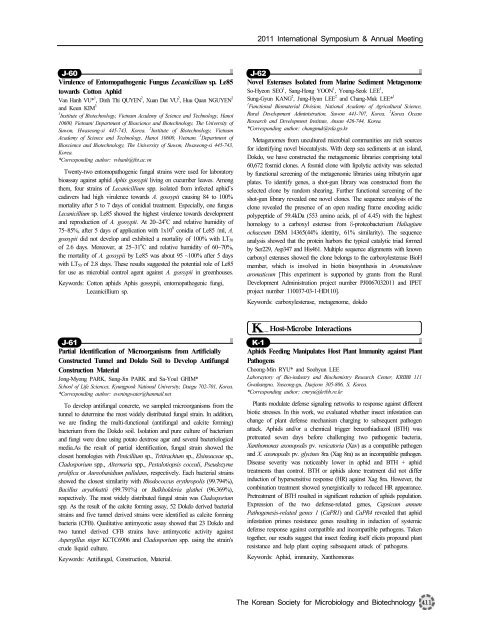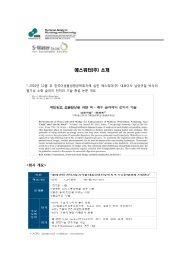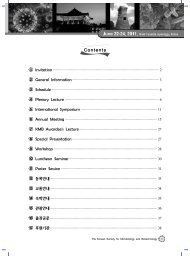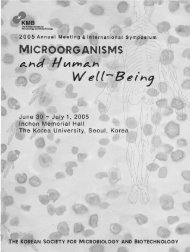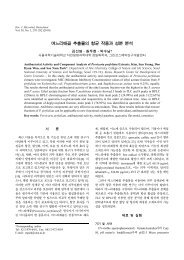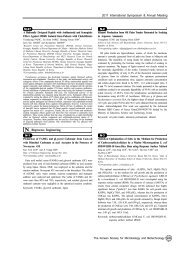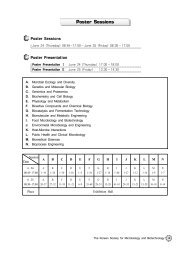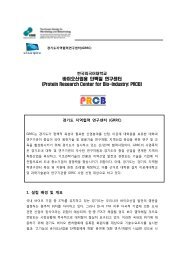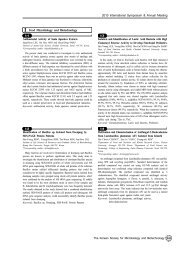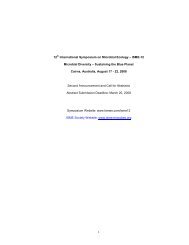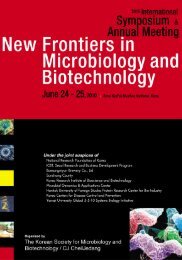J_Environmetal Microbiology and Engineering
J_Environmetal Microbiology and Engineering
J_Environmetal Microbiology and Engineering
Create successful ePaper yourself
Turn your PDF publications into a flip-book with our unique Google optimized e-Paper software.
Virulence of Entomopathogenic Fungus Lecanicilium sp. Le85<br />
towards Cotton Aphid<br />
Van Hanh VU* 1 , Dinh Thi QUYEN 2 , Xuan Dat VU 2 , Huu Quan NGUYEN 2<br />
<strong>and</strong> Keun KIM 3<br />
1<br />
Institute of Biotechnology, Vietnam Academy of Science <strong>and</strong> Technology, Hanoi<br />
10600, Vietnam/ Department of Bioscience <strong>and</strong> Biotechnology, The University of<br />
Suwon, Hwaseong-si 445-743, Korea. 2 Institute of Biotechnology, Vietnam<br />
Academy of Science <strong>and</strong> Technology, Hanoi 10600, Vietnam. 3 J-60<br />
Department of<br />
Bioscience <strong>and</strong> Biotechnology, The University of Suwon, Hwaseong-si 445-743,<br />
Korea.<br />
*Corresponding author: vvhanh@ibt.ac.vn<br />
Twenty-two entomopathogenic fungal strains were used for laboratory<br />
bioassay against aphid Aphis gossypii living on cucumber leaves. Among<br />
them, four strains of Lecanicillium spp. isolated from infected aphid’s<br />
cadavers had high virulence towards A. gossypii causing 84 to 100%<br />
mortality after 5 to 7 days of conidial treatment. Especially, one fungus<br />
Lecanicillium sp. Le85 showed the highest virulence towards development<br />
<strong>and</strong> reproduction of A. gossypii. At 20~24 o C <strong>and</strong> relative humidity of<br />
75~85%, after 5 days of application with 1x10 8 conidia of Le85 /ml, A.<br />
gossypii did not develop <strong>and</strong> exhibited a mortality of 100% with LT50<br />
of 2.6 days. Moreover, at 25~31 o C <strong>and</strong> relative humidity of 60~70%,<br />
the mortality of A. gossypii by Le85 was about 95 ~100% after 5 days<br />
with LT50 of 2.8 days. These results suggested the potential role of Le85<br />
for use as microbial control agent against A. gossypii in greenhouses.<br />
Keywords: Cotton aphids Aphis gossypii, entomopathogenic fungi,<br />
Lecanicillium sp.<br />
J-61<br />
Partial Identification of Microorganisms from Artificially<br />
Constructed Tunnel <strong>and</strong> Dokdo Soil to Develop Antifungal<br />
Construction Material<br />
Jong-Myong PARK, Sung-Jin PARK <strong>and</strong> Sa-Youl GHIM*<br />
School of Life Sciences, Kyungpook National University, Daegu 702-701, Korea.<br />
*Corresponding author: eveningwater@hanmail.net<br />
To develop antifungal concrete, we sampled microorganisms from the<br />
tunnel to determine the most widely distributed fungal strain. In addition,<br />
we are finding the multi-functional (antifungal <strong>and</strong> calcite forming)<br />
bacterium from the Dokdo soil. Isolation <strong>and</strong> pure culture of bacterium<br />
<strong>and</strong> fungi were done using potato dextrose agar <strong>and</strong> several bacteriological<br />
media.As the result of partial identification, fungal strain showed the<br />
closest homologies with Penicillium sp., Tritirachium sp., Elsinoaceae sp.,<br />
Cladosporium spp., Alternaria spp., Pestalotiopsis cocculi, Pseudozyme<br />
prolifica or Aureobasidium pullulans, respectively. Each bacterial strains<br />
showed the closest similarity with Rhodococcus erythropolis (99.794%),<br />
Bacillus aryabhattii (99.791%) or Bulkholderia glathei (96.369%),<br />
respectively. The most widely distributed fungal strain was Cladosporium<br />
spp. As the result of the calcite forming assay, 52 Dokdo derived bacterial<br />
strains <strong>and</strong> five tunnel derived strains were identified as calcite forming<br />
bacteria (CFB). Qualitative antimycotic assay showed that 23 Dokdo <strong>and</strong><br />
two tunnel derived CFB strains have antimycotic activity against<br />
Aspergillus niger KCTC6906 <strong>and</strong> Cladosporium spp. using the strain's<br />
crude liquid culture.<br />
Keywords: Antifungal, Construction, Material.<br />
2011 International Symposium & Annual Meeting<br />
Novel Esterases Isolated from Marine Sediment Metagenome<br />
So-Hyeon SEO 1 , Sang-Hong YOON 1 , Young-Seok LEE 1 ,<br />
Sung-Gyun KANG 2 , Jung-Hyun LEE 2 <strong>and</strong> Chang-Muk LEE* 1<br />
1<br />
Functional Biomaterial Division, National Academy of Agricultural Science,<br />
Rural Development Administration, Suwon 441-707, Korea. 2 J-62<br />
Korea Ocean<br />
Research <strong>and</strong> Development Institute, Ansan 426-744, Korea.<br />
*Corresponding author: changmuk@rda.go.kr<br />
Metagenomes from uncultured microbial communities are rich sources<br />
for identifying novel biocatalysts. With deep sea sediments at an isl<strong>and</strong>,<br />
Dokdo, we have constructed the metagenomic libraries comprising total<br />
60,672 fosmid clones. A fosmid clone with lipolytic activity was selected<br />
by functional screening of the metagenomic libraries using tributyrin agar<br />
plates. To identify genes, a shot-gun library was constructed from the<br />
selected clone by r<strong>and</strong>om shearing. Further functional screening of the<br />
shot-gun library revealed one novel clones. The sequence analysis of the<br />
clone revealed the presence of an open reading frame encoding acidic<br />
polypeptide of 59.4kDa (553 amino acids, pI of 4.45) with the highest<br />
homology to a carboxyl esterase from δ-proteobacterium Haliagium<br />
ochaceum DSM 14365(44% identity, 61% similarity). The sequence<br />
analysis showed that the protein harbors the typical catalytic triad formed<br />
by Ser229, Asp347 <strong>and</strong> His461. Multiple sequence alignments with known<br />
carboxyl esterases showed the clone belongs to the carboxylesterase BioH<br />
member, which is involved in biotin biosynthesis in Aromatoleum<br />
aromaticum [This experiment is supported by grants from the Rural<br />
Development Administration project number PJ0067032011 <strong>and</strong> IPET<br />
project number 110037-03-1-HD110].<br />
Keywords: carboxylesterase, metagenome, dokdo<br />
K_ Host-Microbe Interactions<br />
K-1<br />
Aphids Feeding Manipulates Host Plant Immunity against Plant<br />
Pathogens<br />
Choong-Min RYU* <strong>and</strong> Soohyun LEE<br />
Laboraytory of Bio-industry <strong>and</strong> Biochemistry Research Center, KRIBB 111<br />
Gwahangno, Yuseong-gu, Daejeon 305-806, S. Korea.<br />
*Corresponding author: cmryu@kribb.re.kr<br />
Plants modulate defense signaling networks to response against different<br />
biotic stresses. In this work, we evaluated whether insect infestation can<br />
change of plant defense mechanism charging to subsequent pathogen<br />
attack. Aphids <strong>and</strong>/or a chemical trigger benzothiadiazol (BTH) was<br />
pretreated seven days before challenging two pathogenic bacteria,<br />
Xanthomonas axonopodis pv. vesicatoria (Xav) as a compatible pathogen<br />
<strong>and</strong> X. axonopodis pv. glycines 8ra (Xag 8ra) as an incompatible pathogen.<br />
Disease severity was noticeably lower in aphid <strong>and</strong> BTH + aphid<br />
treatments than control. BTH or aphids alone treatment did not differ<br />
induction of hypersensitive response (HR) against Xag 8ra. However, the<br />
combination treatment showed synergistically to reduced HR appearance.<br />
Pretreatment of BTH resulted in significant reduction of aphids population.<br />
Expression of the two defense-related genes, Capsicum annum<br />
Pathogenesis-related genes 1 (CaPR1) <strong>and</strong> CaPR4 revealed that aphid<br />
infestation primes resistance genes resulting in induction of systemic<br />
defense response against compatible <strong>and</strong> incompatible pathogens. Taken<br />
together, our results suggest that insect feeding itself elicits propound plant<br />
resistance <strong>and</strong> help plant coping subsequent attack of pathogens.<br />
Keywords: Aphid, immunity, Xanthomonas<br />
The Korean Society for <strong>Microbiology</strong> <strong>and</strong> Biotechnology<br />
411


